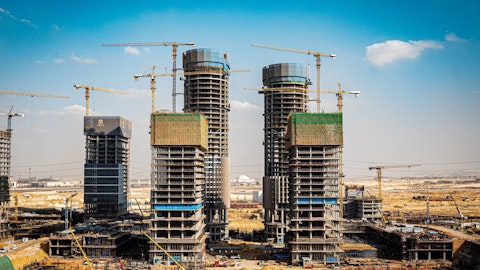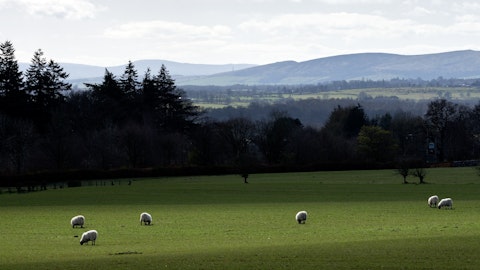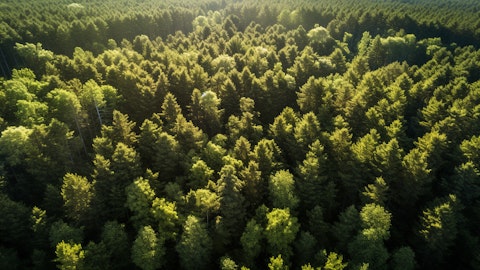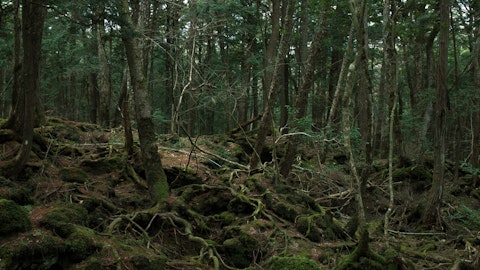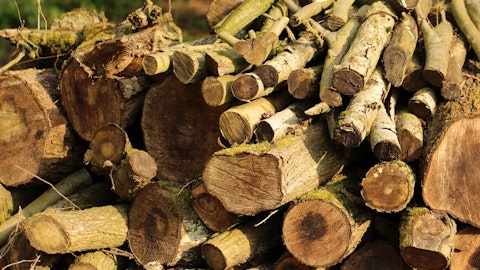They’re not as attention for us in in a lot of the wood baskets in Arkansas and Alabama, Mississippi, so pricing may take a little more time to move there. But when we do see demand pick up, I think that’s where we’ll see bigger price increases in that region.
Anthony Pettinari: Got it.
Eric Cremers: And then yes, on the mix side. Sorry, go ahead or wood mix? Yes, the hardwood mix. Yes. For Yes. On the hardwood mix that’s — I mean it’s probably in the neighborhood. It’s only gone up a couple of percentage points, maybe 5% to 10% here in the quarter.
Anthony Pettinari: Got it. And then just shifting gears. You talked about, I think, monetization of the credit project, I think, in the second half of the year. Just wondering if you could talk about sort of the activities that need to be completed in order to make that happen? And are you working with third parties or marketers, registries, just sort of anything you can kind of share on the kind of time line and the steps?
Eric Cremers: Yes. So we’re deep into the process now, Anthony. The first step really is to bring in an order that will do the math and prove out to the investing public, if you will, that the credits are for real. And that’s a rather lengthy process. And as you can imagine, in this kind of net 0 environment that we’re in the demand for these auditors is sky high. And it’s not just for timberland projects. It runs a gamut of how you get carbon out of the atmosphere. So these folks, these consulting firms are in very high demand. But if you want to have quality credits, you got to have them monitored by an independent third-party that’s got a good reputation. And so that’s the process that we’re going through. We expect to have that process done by, I would say, perhaps early in the third quarter.
And shortly after we get them verified, we’re going to put them out to bid. And we’ve lined up Vera, which is one of the two large firms that sell carbon credits around the world, great reputation and they’re well entrenched in the European market, which is where we think our credits are going to have the most value. And so we expect to monetize those credits shortly after they get the audit comes through. And so that’s probably going to be in the third quarter as well.
Anthony Pettinari: Okay. That’s super helpful. I’ll turn it over.
Eric Cremers: Okay.
Operator: Your next question comes from the line of Ketan Mamtora from BMO Capital Markets. Your line is open.
Ketan Mamtora: Thank you. First question, can you talk a little bit about some of the capacity curtailments that we’ve seen in the U.S. South on the [indiscernible] side, are you surprised that we are seeing capacity curtailments in the U.S. South and related to that, any impact on your wood basket from the recent Arkansas shutdown announcement?
Eric Cremers: No. That’s — I wouldn’t say I’m modestly surprised about the curtailments in the South. I mean everybody talks about cheap fibers in the South. That’s a great place to make lumber much better than up in BC and whatnot, Pacific Northwest. But when you get into some of these specific wood baskets, like I think West Fraser, for example, they closed a mill down in Florida. That was a really tight wood basket, and that’s a relatively small mill. And same thing when you look at I think Boise Cascade, closed the mill in Alabama, West Fraser close, another one in Huttig, Arkansas. Those are smaller mills with tougher cost structures I’m guessing that capital investment may not have happened over the years because the owners recognize that long term, the mills couldn’t be competitive.
So yes, I’m not surprised, I guess, at the end of the day that some mills have closed in the South. To answer the second part of your question, did the West Fraser Mill and Huttig impact us? No, not at all. One of our competitors has got a large block of timberland near that mill, and they were the primary supplier to Huttig. So no impact to us.
Ketan Mamtora: Understood. Now that’s helpful. And then can you talk a little bit about sort of the M&A pipeline on the timberland side, obviously, you did kind of a small bolt-on. But in general, kind of how does the pipeline look right now?
Eric Cremers: Yes. I’d tell you the M&A market is really tight. I’d say typically $3 billion to $4 billion of timberland trades hands each year, and I think something like last year, maybe $1.5 billion traded hands. And I think sellers, they’re basically holding off waiting for maybe housing and lumber prices to improve, perhaps interest rates to come down or, frankly, maybe more importantly, for carbon deals become more mainstream. And carbon is having a bigger and bigger deal. I think that’s 1 of the takeaways for this call. When you look at the transaction that we had with FIA, it was with the — ultimately, it was a European investor, not FIA, it’s going to own those trees. We sold trees that were, I think, 3.8 years old for $1,700 an acre.
What was it 5 years ago, you’d buy average age timberland in the South for $1,700 an acre. Carbon is having a bigger and bigger deal. And especially if you look at the large sums of capital that have been raised to pursue timberland for a carbon outcome. I could reference a bunch. Oak Hill raised $1.8 billion. They bought 1.7 million acres from forest land. Manulife said it was raising $500 million for timber carbon offsets. JPMorgan acquired Campbell Global, a TMO and then subsequently bought 250,000 acres for $500 million in the South, Goldman Sachs and Apple just raised $200 million for a carbon offset fund. So I think people are holding off bringing their timberland to market waiting for this capital to get raised and then waiting for it to desperately look for a home because that ultimately is going to push up timberland values.
Ketan Mamtora: Got it. That’s very helpful. I’ll done it over. Good luck.
Eric Cremers: Thanks.
Operator: Your next question comes from the line of Michael Roxland from Truist Securities. Your line is open.
Michael Roxland: Thank you, Eric and Wayne for taking my questions. My first question, just can you help me just understand what’s happening with respect to margins in wood products? Just following up on what George was asking earlier. Because when I look back historically, when there were periods of time when you had lower prices, lower volumes, you still manage to generate mid-single digit, high-single digit EBITDA margins. So I’m just wondering what — is there something going on from a cost vantage point that’s negatively impacting your performance in wood products?
Eric Cremers: Well, yes, certainly, Michael. There is — in the inflationary environment we’ve seen over the past year or two costs of running sawmills have — its moved up meaningfully. And what you saw this past year and particularly in the fourth quarter is with the higher interest rates, demand has dropped. And it dropped to the point where capacity utilization in the industry is at the lowest it’s been, I think, since going back to 2013 is what I read the other day. But whenever you get into a situation in a commodity industry where capacity utilization is the rock bottom levels, you’re going to see prices collapse as everybody tries to keep their mills running full and subsequently prices come down. I mean I am happy that our lumber margins in Q4, while they’re negative, I’m certainly not happy about that.
